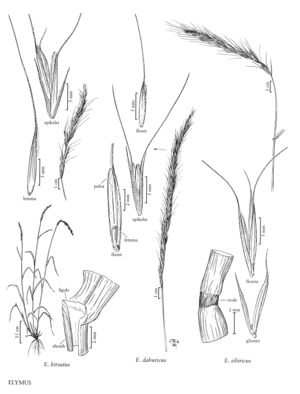Elymus hirsutus
Plants cespitose, sometimes shortly rhizomatous. Culms 40-140 cm, usually somewhat decumbent; nodes 4-7, mostly exposed, usually glabrous, occasionally puberulent. Leaves evenly distributed; sheaths usually glabrous and smooth, occasionally scabridulous or retrorsely hairy, sometimes purplish; auricles to 1.5 mm, often absent; ligules to 1 mm; blades 4-12 mm wide, lax, usually deep green, adaxial surfaces usually pilose or villous, occasionally puberulent or scabridulous. Spikes 6-20 cm long, 0.5-2 cm wide, nodding to pendent, with 2 spikelets per node, rarely with 3 at some nodes; internodes 3-10(12) mm long, 0.2-0.7 mm thick at the thinnest sections, usually glabrous, sometimes sparsely hairy. Spikelets 12-20 mm, appressed to divergent, sometimes purplish at higher latitudes, with 2-4(7) florets, lowest florets functional; disarticulation above the glumes and beneath each floret. Glumes equal or subequal, the bases flat, occasionally indurate for 0.5 mm, veins usually evident, glume bodies (4.5)7-10(11) mm long, 0.7-1.5 mm wide, linear-lanceolate, entire, widening or parallel-sided above the base, 3-5-veined, usually scabridulous to scabrous, veins occasionally hirsute beyond midlength, margins hyaline or scarious, awns 1-10 mm, straight; lemmas 7-14 mm, smooth or scabridulous, lateral veins hairy, margins hairy beyond midlength, marginal hairs 0.5-1 mm, longer than those elsewhere, awns (2)8-30 mm, flexuous to moderately outcurving; paleas 6-13 mm, with hairs of varying lengths on the keels and apices, acute, bidentate; anthers 2-3.5 mm. Anthesis from May to July. 2n = 28.
Distribution
Oreg., Alaska, Calif., Wash., B.C.
Discussion
Elymus hirsutus grows in moist to damp or dry soils in woods, thickets, and grasslands. Its range extends along the coastal mountains from the Aleutian Islands to northern Oregon, and inland to eastern British Columbia. Plants in the southern part of the range tend to have villous leaves and more erect spikes with shorter, straighter awns.
Elymus hirsutus is similar to E. glaucus (see previous), but its more pendent spikes, lemma pubescence pattern, and shorter glumes enable most specimens to be readily identified. Intermediates do exist; it is not known whether they reflect introgression or extremes of variation. Elymus hirsutus occasionally hybridizes with Leymus mollis (p. 356) and Hordeum brachyantherum (p. 243).
Selected References
None.
